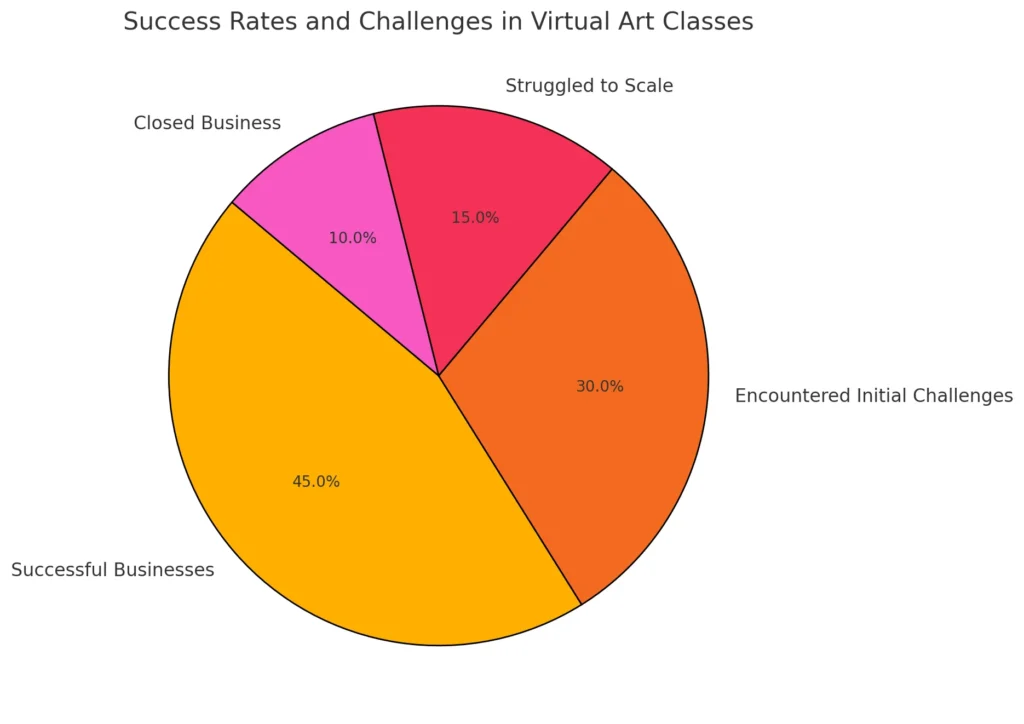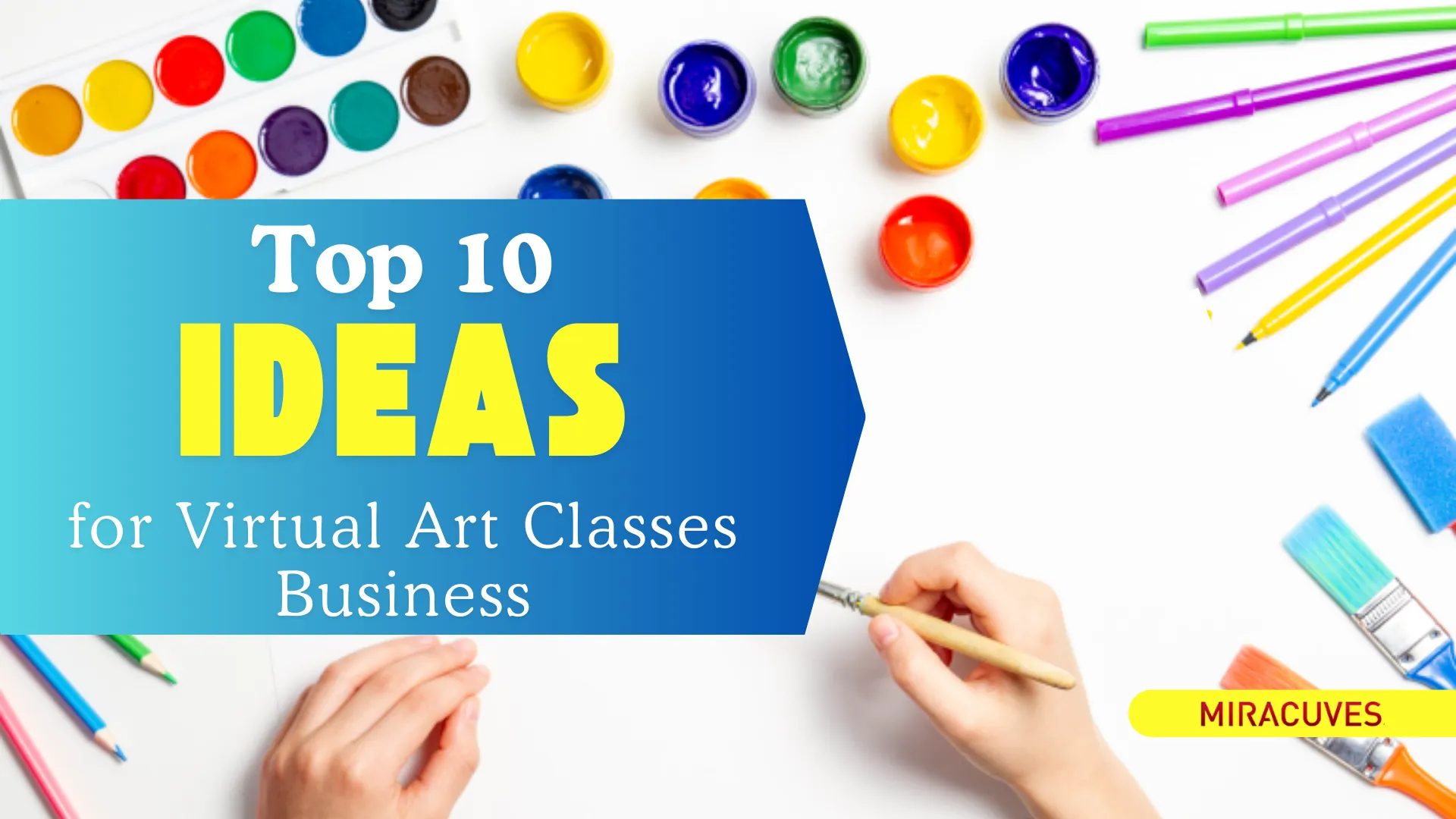In today’s fast-paced digital world, virtual art classes have surged in popularity, attracting a wide range of creative enthusiasts eager to learn from the comfort of home. As the online education industry continues to grow, the art niche has carved a unique and vibrant space for itself, blending convenience, creativity, and accessibility. Starting a virtual art class business can be an exciting venture, offering flexibility and a low overhead cost model that appeals to both budding artists and entrepreneurs.
Virtual art classes cater to varied audiences, from beginners seeking a creative outlet to advanced learners looking to refine their skills. As the demand for digital learning and artistic expression grows, so does the potential for entrepreneurs to tap into this market. This article will explore ten unique, profitable ideas to help you launch your own virtual art class business and capitalize on this growing trend.
| Métrica | Estatísticas | Descrição |
|---|---|---|
| Tamanho do mercado | $9.18 billion (2023) – $17.76 billion (2030) | Estimated size of the online art education market globally. |
| Taxa de crescimento anual | 15-20% | Average year-over-year growth in the virtual art industry. |
| User Demographics | 60% Adults, 40% Children | Breakdown of primary user age groups for virtual art classes. |
| Popular Platforms | Video Conferencing, Interactive Apps | Common platforms used for hosting virtual art classes. |
| Trending Art Forms | Digital Art, Watercolor, Sketching | High-demand art types being taught in virtual settings. |
Why Choose Virtual Art Classes?
Virtual art classes have become a popular choice for both learners and instructors, creating a dynamic space for art enthusiasts to connect globally. One of the key reasons for their growing demand is accessibility—students can join from anywhere, eliminating geographical barriers that traditional classes face. This flexibility allows more people to explore their creative side, with options ranging from casual lessons to structured, skill-building programs.
The potential for growth in virtual art classes is remarkable. Online learning platforms have reported a steady increase in enrollment, especially in creative courses, with digital art and multimedia arts leading the way. As people seek new ways to learn and relax, the appeal of art classes has widened beyond traditional age groups, attracting adults and children alike.
Additionally, the business model for virtual art classes is highly scalable, with options for both live and pre-recorded sessions. Entrepreneurs can customize their offerings to target specific skill levels or art forms, whether it’s a beginner-friendly drawing course or an advanced digital illustration class. This adaptability, combined with a low-cost startup model, makes virtual art classes an appealing choice for anyone looking to build a successful business in the arts.
Current Trends and Future Opportunities in Virtual Art Classes
The world of virtual art education is constantly evolving, driven by new technologies and shifting consumer preferences. Today’s virtual art classes are no longer just about watching videos; they are interactive, personalized, and increasingly sophisticated. Real-time feedback through video conferencing, virtual drawing boards, and interactive tools are transforming the learning experience, allowing instructors to engage students in ways that feel almost as personal as in-person lessons.
| Tendência/Tecnologia | Descrição | Impact on Virtual Art Classes |
|---|---|---|
| Inteligência Artificial (IA) | AI tools that provide personalized feedback and adaptive learning paths. | Enhances the learning experience by tailoring guidance to individual skill levels. |
| Realidade Aumentada (RA) | AR features allowing students to visualize art in 3D or overlay guides. | Makes classes more interactive and immersive, aiding hands-on practice. |
| Virtual Drawing Boards | Digital whiteboards and drawing tools for real-time collaboration. | Enables real-time feedback and group participation in a virtual setting. |
| Niche Specialization | Focused classes on specific art forms like calligraphy or eco-friendly art. | Attracts dedicated audiences with specific interests, improving market appeal. |
| Self-Paced Courses | Pre-recorded lessons allowing students to learn at their own pace. | Increases accessibility and convenience for diverse learning schedules. |
One of the major trends in virtual art classes is the integration of Artificial Intelligence (AI) and Augmented Reality (AR) tools. These technologies allow students to see 3D models, explore complex art techniques, and practice with digital guidance, all from their screens. For example, an AR feature might enable a student to visualize how their painting would look on a wall or provide step-by-step guidance as they draw. As these technologies become more accessible, they open exciting new possibilities for both instructors and students, making classes more immersive and practical.
Another significant trend is the focus on niche art forms and specialized courses. Instead of generic lessons, many instructors now offer classes that cater to specific interests, such as digital painting, calligraphy, or even eco-friendly art techniques using sustainable materials. This specialization not only attracts a dedicated audience but also allows instructors to stand out in the competitive online space.
Top 10 Ideas for Starting a Virtual Art Class Business
If you’re considering a virtual art class business, there are many unique and profitable directions you can take. Here are the top 10 ideas, each tailored to attract a specific audience while offering diverse and creative ways to engage students online.
| Virtual Art Class Idea | Mercado Alvo | Custos estimados de inicialização | Potencial de lucro |
|---|---|---|---|
| Beginner Drawing Basics | Absolute beginners | Baixo | Moderado |
| Digital Painting for Teens | Teens interested in digital art | Moderado | Alto |
| Watercolor Techniques for Adults | Adults seeking creative stress relief | Baixo a moderado | Alto |
| Mixed Media Art for Kids | Children aged 5-12 | Baixo | Moderado |
| Illustration for Aspiring Authors | Aspiring writers and illustrators | Moderado | Alto |
| Eco-Friendly Art and Sustainable Techniques | Environmentally-minded learners | Baixo a moderado | Moderado |
| Portrait Drawing and Realism | Intermediate learners and artists | Baixo | Alto |
| Calligraphy and Hand Lettering | Art enthusiasts, DIY crafters | Baixo | Alto |
| Advanced Abstract Art Techniques | Advanced learners, contemporary art enthusiasts | Moderado | Alto |
| Art Therapy and Mindfulness Through Art | Adults seeking mental wellness | Baixo | Moderado |
1. Beginner Drawing Basics
Offer foundational courses in drawing for absolute beginners, covering shading, proportions, and perspectives.
- Mercado-alvo: Absolute beginners
- Custos estimados: Low (basic drawing tools like pencils, paper)
- Requisitos de inicialização: Teaching materials, beginner-friendly curriculum, simple workspace
2. Digital Painting for Teens
Teach digital painting techniques for teens, including character design and digital landscapes.
- Mercado-alvo: Teens interested in digital art
- Custos estimados: Moderate (digital art software, tablets)
- Requisitos de inicialização: Digital art software, drawing tablets, structured lessons in digital art
3. Watercolor Techniques for Adults
Provide a watercolor course focused on blending, layering, and relaxation techniques for adults.
- Mercado-alvo: Adults looking for creative stress relief
- Custos estimados: Low to moderate (watercolor paper, paints, brushes)
- Requisitos de inicialização: Watercolor supplies, calming workspace, structured curriculum
4. Mixed Media Art for Kids
Explore various materials and mediums with children, promoting creativity through experimentation.
- Mercado-alvo: Children aged 5-12
- Custos estimados: Low (paint, crayons, collage materials)
- Requisitos de inicialização: Basic art supplies, child-safe workspace, engaging lesson plans
5. Illustration for Aspiring Authors
Teach aspiring writers and illustrators how to illustrate their own stories, focusing on storytelling and character development.
- Mercado-alvo: Aspiring writers and illustrators
- Custos estimados: Moderate (illustration tools or software)
- Requisitos de inicialização: Illustration tools or digital software, curriculum on storytelling in art, teaching space
6. Eco-Friendly Art and Sustainable Techniques
Teach students how to create art using eco-friendly materials, appealing to environmentally conscious learners.
- Mercado-alvo: Environmentally-minded adults and teens
- Custos estimados: Low to moderate (sustainable materials)
- Requisitos de inicialização: Sustainable art supplies, eco-conscious lesson plans, reusable or recycled materials
7. Portrait Drawing and Realism
Offer a class on realistic portrait drawing, focusing on anatomy, facial expressions, and lifelike shading.
- Mercado-alvo: Intermediate learners and artists
- Custos estimados: Low (high-quality drawing materials)
- Requisitos de inicialização: Charcoal, pencils, high-quality paper, detailed lesson plans on portrait drawing
8. Calligraphy and Hand Lettering
Teach traditional and modern calligraphy techniques for art enthusiasts and DIY crafters.
- Mercado-alvo: Art enthusiasts, DIY crafters
- Custos estimados: Low (calligraphy pens, brushes, ink)
- Requisitos de inicialização: Calligraphy supplies, instructional materials, sample projects
9. Advanced Abstract Art Techniques
Explore advanced abstract techniques, covering color theory, composition, and emotional expression.
- Mercado-alvo: Advanced learners, contemporary art enthusiasts
- Custos estimados: Moderate (varied paints, brushes, canvases)
- Requisitos de inicialização: Abstract art supplies, access to advanced materials, structured lessons on abstract concepts
10. Art Therapy and Mindfulness Through Art
Guide adults in mindfulness through art, using drawing or painting as tools for self-expression and relaxation.
- Mercado-alvo: Adults seeking mental wellness activities
- Custos estimados: Low (basic materials like paper, pencils, paints)
- Requisitos de inicialização: Art supplies, comfortable environment, curriculum on mindfulness and therapeutic practices
Exemplos do mundo real
Real-world examples are a powerful way to demonstrate the success and possibilities of virtual art class businesses. Many artists, educators, and entrepreneurs have built thriving online art programs, often starting small and scaling up as demand grows. These examples showcase how diverse approaches—ranging from niche specializations to broader art classes—can find success in the virtual art space.

One popular approach has been creating community-driven classes, where students learn in small, interactive groups. Instructors often organize live sessions, allowing students to receive immediate feedback, participate in group critiques, and build connections with others who share similar interests. For instance, digital illustration classes for teens often focus on character creation and social media art trends, creating an environment where students feel connected to popular digital culture.
Another successful model is offering a library of pre-recorded classes. This self-paced approach appeals to adult learners who want flexibility in their schedules. Classes like watercolor painting or hand lettering often thrive in this format, as students can revisit techniques and follow along at their own pace, even if their schedules don’t allow live participation.
Additionally, themed workshops focusing on wellness, such as art therapy classes, have grown in popularity. These classes help participants use art as a tool for relaxation, mindfulness, and self-care, which has especially resonated with audiences during times of increased stress.
Mistakes to Avoid When Starting a Virtual Art Class Business
| Erro comum | Medida preventiva |
|---|---|
| Failing to identify the target audience | Conduct thorough audience research to tailor content to specific needs. |
| Inconsistent content quality | Invest in quality lighting, camera, and microphone for professional visuals. |
| Incorrect pricing strategy | Perform competitive analysis to set balanced, appealing prices. |
| Neglecting community-building | Create interactive spaces for discussions, Q&As, and feedback to foster engagement. |
| Lack of marketing focus | Develop a basic marketing plan to consistently attract and retain students. |
Starting a virtual art class business is an exciting journey, but there are common pitfalls that can hinder success if overlooked. Understanding these mistakes in advance can make a huge difference, helping you build a more resilient and rewarding business from the start.
Um dos erros mais frequentes é subestimar a importância de audience research. Not every art course appeals to every audience, so it’s essential to know exactly who you’re targeting. For example, a course in digital illustration for teens will differ significantly from a watercolor therapy class for adults. Failing to identify your audience’s specific needs and preferences can result in low enrollment and engagement.
Another common error is inconsistent content quality. Virtual art classes rely on clear, high-quality visuals, whether live or pre-recorded. Poor lighting, unclear instructions, or inadequate camera angles can frustrate students and affect the learning experience. Investing in a quality camera, lighting, and microphone setup can go a long way in maintaining professional standards and retaining students.
Pricing is another area where new virtual art class businesses often stumble. Setting prices too low may undervalue your expertise, while setting them too high could drive potential students away. It’s important to conduct a competitive analysis and align your pricing with the value and uniqueness of your offerings.
Lastly, neglecting to build a community around your classes can limit growth. Students who feel part of a community are more likely to stay engaged, return for future courses, and recommend your classes to others. Building an interactive space for feedback, Q&As, or group discussions can create a sense of belonging and increase the value of your program.
Por que confiar na Miracuves Solutions para seu próximo projeto?
When it comes to building a virtual art class business, escolhendo o parceiro certo can make all the difference. Miracuves Solutions is dedicated to helping you bring your vision to life with expertise and a proven track record in app and platform development. We understand the unique demands of virtual learning environments and prioritize delivering seamless, high-quality digital solutions that cater specifically to the needs of art educators and students.
Miracuves Solutions stands out not only for its technical capabilities but also for its client-focused approach. We work closely with each client to understand their goals, challenges, and audience, ensuring that every solution we create is tailored to enhance the learning experience and support business growth. Whether you need an interactive live-streaming platform, robust content management features, or tools for student engagement, Miracuves Solutions provides reliable, innovative solutions that meet the highest industry standards.
Our commitment to client success goes beyond the technical; we’re here to support you every step of the way, from initial planning to launch and beyond. With a history of successful projects and satisfied clients, Miracuves Solutions is the trusted choice for entrepreneurs looking to make a real impact in the virtual art education space.
Conclusão
Starting a virtual art class business presents a rewarding opportunity for aspiring entrepreneurs and artists alike. With the growing demand for online creative education, there has never been a better time to turn a passion for art into a profitable and impactful venture. From understanding the latest trends to exploring unique class ideas, building a solid foundation is essential for long-term success in this dynamic market.
Whether you’re planning to teach beginners, explore niche art forms, or focus on mindfulness through art, your virtual art classes can inspire creativity and connect with audiences worldwide. Embrace the journey, stay true to your vision, and remember that every successful business begins with a single step forward. Now is the time to transform your ideas into reality and join the vibrant world of online art education.
Perguntas frequentes
What skills do I need to start a virtual art class business?
To start a virtual art class business, you’ll need basic art and teaching skills, along with some technical know-how for online platforms. Marketing and communication skills can also help attract and retain students.
How much does it cost to start a virtual art class business?
The cost varies depending on the type of class and materials required. Generally, starting costs are low, with basic equipment like a camera, microphone, and art supplies. You may need to invest more if using specialized software or creating a professional setup.
How do I attract students to my virtual art class?
You can attract students by promoting your classes on social media, collaborating with influencers, offering free introductory sessions, and maintaining a professional, engaging website or platform for sign-ups.
Can I teach different types of art in one virtual art class business?
Yes, offering a variety of art classes can help you reach a wider audience. However, it’s best to start with a few focused courses before expanding to different types of art to build a solid reputation.
Is a virtual art class business profitable?
Yes, a virtual art class business can be profitable with a steady flow of students and well-marketed courses. Profitability also increases with flexible offerings like subscription plans, premium classes, or specialized workshops.





























































